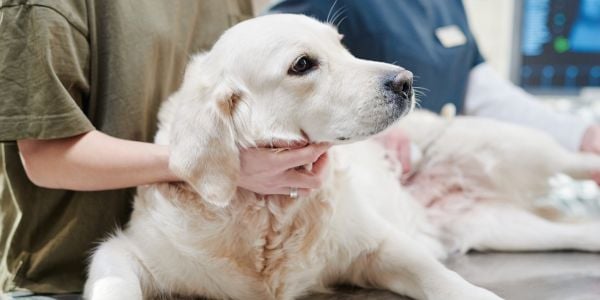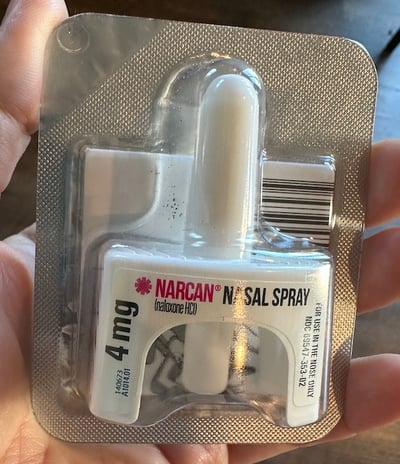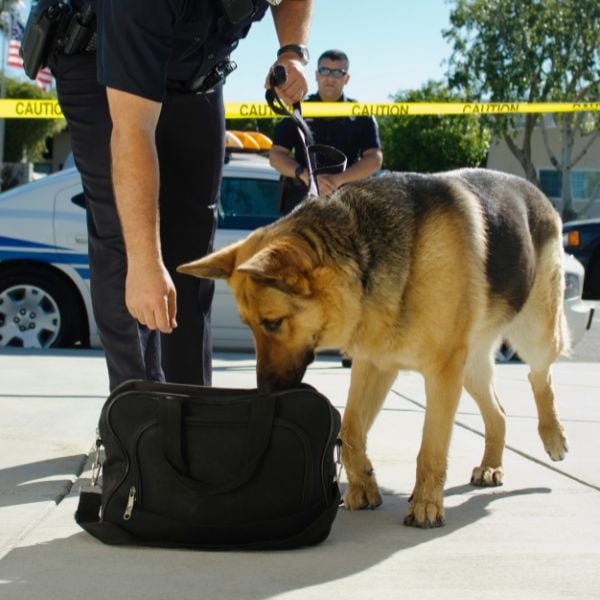 If you know or suspect your dog has consumed or been exposed to any type of drug, contact Pet Poison Helpline (855) 764-7661, ASPCA Animal Poison Control Center (888) 426-4435, and/or seek veterinary care IMMEDIATELY.
If you know or suspect your dog has consumed or been exposed to any type of drug, contact Pet Poison Helpline (855) 764-7661, ASPCA Animal Poison Control Center (888) 426-4435, and/or seek veterinary care IMMEDIATELY.
Be sure to inform the veterinarian what you know or suspect your pet was exposed to, whether it is legal or not.
The veterinary team’s primary concern is saving your pet and not ‘telling’ on you. The information you share is confidential. Withholding any information could cost your pet their life.
Each year, the American Society for the Prevention of Cruelty to Animals (ASPCA) Animal Poison Control Center (APCC) releases a list of the top ten toxins for pets. This year, there was a new addition to their list. For the first time ever, recreational drugs (e.g., marijuana, hallucinogenic mushrooms, and cocaine) were one of the top ten toxins to pets.
Recreational drugs made the list likely because there was an 11% increase in calls related to potential marijuana ingestions from 2021 to 2022. And in the past five years, there has been a 300% increase in these types of calls.
Both human medications and over-the-counter medications (e.g., pain medications) have remained on the top ten toxin list for over 10 years.
A consistent among the top ten toxins includes human food. There are many foods that have obvious as well as hidden toxins for pets. Knowing what items are toxic (e.g., onions and garlic, certain nuts, etc.) and which are safe (e.g., green beans or blueberries) can help you and your pet avoid an emergency visit to the veterinarian.
Knowledge is power. So, it's important you are aware of what potential toxins exist in your home (e.g., xylitol, grapes and raisins, plants, pain medications, etc.) and what steps you should take if your pet is exposed. Since pet owners are becoming more aware of the dangers that different types of medications (and other household items) pose to their pets and their symptoms, the APCC has seen continual increases in their call volumes yearly.
While this article will focus on the categories relating to some of the toxic drugs to pets, I strongly encourage you to read the articles linked above, discussing common toxins and their dangers to pets.
Skip to section:
Recreational Drug Toxicity in Dogs
This is a broad category and includes a variety of compounds. The prime sources are botanical (including concentrated products), as well as synthesized chemicals, industrial chemicals, and therapeutic drugs.
Dogs are curious creatures and will try almost anything, making accidental ingestion the prime way they become exposed. But there are instances where pets are purposely and, in some cases, maliciously given these drugs. So, don't delay seeking veterinary care if you notice the symptoms outlined below and suspect your pet may have eaten something accidentally at home, in your yard, or on a walk.
The drugs that dogs are more commonly exposed to are those that are more readily abused by humans. The top five illicit drugs* dogs are exposed to per the APCC include the following ones.
*Illicit drug: Any drug that has been declared under federal and/or state laws to be illegal to possess, use, or distribute without authorization.
Marijuana and Other Cannabinoids
Marijuana-laced baked goods (cookies, butter, brownies, etc.) account for most cases received by the APCC. They are more dangerous than the ingestion of the plant material, as baked goods can contain additional toxins (e.g., chocolate or xylitol) beyond the marijuana.
Another common form of exposure is inhalation of the smoke. Dogs can also be exposed through the skin (topical oils, creams, or balms) or by products made with hashish (a more potent and concentrated form of cannabis).
Note: There are reports of pets developing THC symptoms following ingestion of CBD products. This is likely due to the fact that there are no regulations on over-the-counter CBD products. Therefore, you must use caution if you decide to use them.
Symptoms of Marijuana Intoxication in Dogs
Typically, signs of intoxication are noticed about 30 to 60 minutes following ingestion. Signs can appear sooner following inhalation of smoke.
- Glassy eyes
- Incoordination
- Dilated pupils
- Excessive drooling
- Vomiting
- Lethargy
- Depression
- Agitation and excitement (includes growling, cowering, jumping as if startled or surprised, and avoidance)
- May be vocal
- Changes in heart rate (either slower or faster)
- Slower respiratory rate
- Urinary incontinence or urinary dribbling
- Serious cases
- Seizures
- Tremors
- Coma

Many years ago, Daisy, a team member's dog, ate an edible in the park on a walk. The photo above was taken just before her symptoms started. Her people hadn't noticed that she had eaten anything, but she had been sniffing around in the grass and loved to sidewalk surf, so they suspected she had eaten something. She showed signs of drowsiness, lack of coordination, and incontinence and appeared startled when they approached her – many of the classic signs of marijuana toxicity. They immediately took her to a vet, where she was put on IV fluids and spent the night in the emergency hospital for monitoring. She was able to go home the next day.
Read below about diagnosing and treating marijuana toxicity.

Amphetamines and Related Drugs – Legal and Illegal forms: Ecstasy (MDMA), Meth, Speed
Dogs can be exposed via ingestion, inhalation, or through their skin. Those drugs that come from unknown origins may contain impurities that cause additional risks.Symptoms of Amphetamine Toxicity in Dogs
Signs are noticed within 30 minutes to 2 hours after exposure.
These drugs can affect the central nervous system as well as the cardiovascular, gastrointestinal, and respiratory systems.
- Agitation
- Aggression
- Apprehension
- Circling
- Diarrhea
- Dilated pupils
- Drooling
- Head bobbing
- Hyperactivity
- Incoordination
- Panting
- Tremors
- Seizures
- Sedation
- Elevated heart rate
- Elevated body temperature
- Late phases of intoxication include depression, lethargy, and coma
- DEATH
Read below about diagnosing and treating amphetamine toxicity.

Cocaine (a.k.a. coke, gold dust, stardust, snow, C, white girl, white lady)
It can be absorbed via most routes, such as orally, topically, and inhalation.
Symptoms of Cocaine Toxicity in Dogs
Signs of intoxication from cocaine can develop as soon as 30 minutes after exposure.
- Vomiting
- Excessive drooling
- Vocalization
- Hyperactivity
- Shaking
- Incoordination
- Panting
- Agitation
- Dilated pupils
- Nervousness
- Tremor
- Seizures
- Elevated heart rate
- Increased blood pressure
- Increased respiratory rate
- Hyperthermia (elevated body temperature)
- DEATH
Read below about diagnosing and treating cocaine toxicity.

Heroin (a.k.a. white girl, lady, black tar, smack, H, horse, brown sugar)
Dogs can be exposed via ingestion, inhalation, and through the skin. Heroin can also be ’cut’ with other ingredients that can worsen its toxic effects. Heroin is commonly mixed with other drugs, such as fentanyl. Cocaine and heroin can also be mixed – this is referred to as speedball.
Symptoms of Heroin Toxicity in Dogs
Signs of intoxication can be noticed within 1 to 30 minutes following exposure.
Since heroin is an opioid drug, it can cause depression of the respiratory and central nervous system. It can also affect the cardiovascular and gastrointestinal systems.
- Constricted pupils (pinpoint)
- Drowsiness
- Incoordination
- Vomiting
- Excessive drooling
- Seizures
- Decreased respiratory rate (watch video on how to take your dog's respiratory and heart rate)
- Decreased heart rate
- Heart arrhythmias (irregular heartbeat)
- Respiratory depression (slow, shallow breathes)
- Hypotension (low blood pressure)
- Constipation
- Coma
- DEATH
Read below about diagnosing and treating heroin toxicity.

Hallucinogenic mushrooms (a.k.a. magic mushrooms, caps, shrooms)
For exposure and toxicity to occur, a dog has to eat the mushrooms. Intoxication from magic mushrooms is not as common as with other recreational drugs.
Due to their bitter or sour taste, they may be coated in chocolate or alcohol, both of which are toxic to dogs. These mushrooms can also be added to foods (e.g., chili or stews, which can also contain onions and garlic, which are toxic) or drinks (e.g., teas or milkshakes), which can increase the likelihood that dogs will consume them.
Symptoms of Hallucinogenic Mushroom Toxicity in Dogs
Signs of intoxication can develop in as little as 30 minutes but can take up to 3 hours.
- Vomiting
- Diarrhea
- Changes in behavior
- Agitation
- Vocalization
- Seizures
- Elevated heart rate
- Elevated body temperature
- Nystagmus (involuntary rapid and repetitive eye movements either horizontally or vertically)
Read below about diagnosing and treating hallucinogenic mushroom toxicity.

Diagnosing Drug Toxicity in Dogs
Veterinarians can use over-the-counter (OTC) drug test kits in order to confirm or exclude a suspected drug toxicosis since they can detect the metabolites of the most commonly available recreational drugs (amphetamines, cocaine, marijuana, opiates, and barbiturates), excluding hallucinogenic mushrooms. However, these tests are not reliable when testing for marijuana in dogs. False negatives can occur.
NEVER DELAY TREATMENT to test your pet at home. As mentioned, these tests are not 100% accurate, and assuming your pet has not consumed drugs based on the test may cost them their life. If your pet shows any symptoms of toxicity, IMMEDIATELY take them to a veterinarian, as time is of the essence.
Note: Inform the veterinarian if your dog is receiving any other medications, as there are some that can cause false positives. For example, fluoxetine (Prozac®) or phenylpropanolamine (PPA) can cause amphetamine/methamphetamine positives, and diphenhydramine (Benadryl®) can cause opioid positives.
Due to the varying sensitivity of these tests, a thorough history that you provide the veterinarian, and the symptoms your dog is having play an important role in properly diagnosing a dog with drug poisoning.
Treatment for Drug Toxicity in Dogs
All five illicit drugs follow the same decontamination protocol (induction of vomiting, bathing, and administering activated charcoal). Since most of these drugs cause symptoms quickly, there is only a narrow window in which decontamination can be successful. It should only be done on dogs that are asymptomatic and stable. The benefits must outweigh the risks.
NEVER INDUCE VOMITING at home unless instructed to do so by a veterinarian. Inducing vomiting on a pet that is weak or unconscious can increase the risk of aspiration pneumonia and other complications.
Marijuana and other cannabinoids
- Treatment involves the management of symptoms (medications to control vomiting or abnormal heart rate) and supportive care (IV fluids, warming blankets). Since signs can last up to 72 hours, it is important for a dog’s vitals (heart rate, blood pressure, and temperature) to be closely monitored. In severe cases, oxygen therapy and intubation may be necessary.
- Deaths are rarely reported. With proper monitoring and treatment, the outcome is excellent.
Amphetamines and related drugs
- Treatment involves the management of symptoms and supportive care. Hospitalization is essential for close monitoring of vitals (heart rate, blood pressure, temperature, as well as electrocardiography (ECG)), evaluating kidney function and urine, as well as thermoregulation (with cooling towels, fans) is critical.
Supportive care involves intravenous fluids to help hydration as well as thermoregulation. Presenting symptoms are managed with medications. - The prognosis and outcome are dependent on the length and severity of symptoms, but it is generally good with prompt and proper treatment. The prognosis isn’t as favorable for dogs that develop seizures, heart issues, and disseminated intravascular coagulation (DIC – deregulation of the body’s normal blood clotting mechanisms).
- Dogs can develop renal failure as a result of amphetamine intoxication.
Cocaine
- Dogs are typically hospitalized for 10 to 30 hours while they receive supportive care (IV fluids) and treatment of their symptoms (with medications).
They will need their vital signs monitored (including ECG), thermoregulation, management of stimuli to avoid central nervous system stimulation, and respiratory support (a ventilator is sometimes needed). Intravenous fluids and medications to manage all symptoms are an important aspect of treatment. - With proper treatment, the prognosis is good.
 Heroin
Heroin
- Treatment is supportive care as well as management of symptoms. There is a reversal agent called naloxone* that is a critical part of treatment as it manages the symptoms of central nervous system depression, seizures, and respiratory depression, which can quickly develop into respiratory arrest and death.
When respiratory depression cannot be managed with naloxone, dogs must be intubated and either oxygen or positive pressure ventilation implemented. In some cases, additional seizure control is needed. - If dogs develop seizures, the prognosis is not good.
* Narcan® (naloxone) nasal spray use in dogs
Across the United States, many law enforcement agencies are equipped with this drug to reverse the effects of an opioid overdose. Soon, it will be available OTC, but some states and cities offer it for free.
If you use Narcan on your dog, they still need to be seen by a veterinarian because they may experience medical issues from the exposure that require additional treatment, and some of these drugs are contaminated with other ingredients that can cause toxic effects not treated by the Narcan. See how to give Narcan to your dog in the video below.
Hallucinogenic Mushrooms
- Treatment involves symptomatic and supportive care. As with other intoxication, monitoring vital parameters, thermoregulation, and reduction of stimuli are important.
A dog must be closely monitored for the development of self-mutilation and other abnormal physical behaviors, which will require special confinement to prevent injury. Other potential toxins, such as chocolate or onions, require additional treatments and care. - With proper monitoring and symptomatic treatments, the prognosis is good.

Other Recreational Drugs That Are Toxic to Dogs
Alcohol
The concentration of the substance determines the amount that will cause toxicity. Alcohol is rapidly absorbed through the gastrointestinal tract and can even be absorbed through the skin.
Symptoms of intoxication begin within 30 to 60 minutes after exposure and include abnormal walking, lethargy, vomiting, extreme sleepiness, abnormal behavior, low body temperature, increased thirst, and urination.
Symptoms noted in severe cases include tremors, seizures, vocalization, elevated heart rate, decreased respiratory rate, coma, and death. Alcohol can lower blood glucose, which can be dangerous, especially for diabetic dogs.
Treatment involves decontamination by inducing vomiting (if the alcohol was consumed) or a bath (if exposed through the skin), as well as symptomatic and supportive care. Hospitalization is typically 24 to 36 hours as it is critical to monitor cardiovascular (blood pressure, heart rate) and neurological parameters (tremors, seizures, level of consciousness) until dogs completely recover.
When dogs receive prompt and proper treatment, the prognosis for recovery is excellent.
Cigarettes and E-cigarettes
The nicotine found in cigarettes and e-cigarettes is toxic to dogs. A dose as low as 1 mg per kilogram of body weight (.5 to 1 mg per pound body weight) can cause toxicity.
For dogs, the median lethal dose following ingestion is 9.2 mg per kilogram of weight. Symptoms of intoxication can be noted within 1 hour of exposure.
Symptoms of nicotine toxicity include tremors, constricted pupils, drooling, excitement, vomiting, diarrhea, hearing and visual hallucinations, twitching, seizures, elevated heart rate (small doses slow heart rate), and elevated blood pressure.
Treatment involves inducing vomiting if consumption is within an hour or so. Gastric lavage (washing the stomach) may be needed and requires a dog to be sedated. Activated charcoal is often administered to bind the nicotine and to help decrease further spread within the body.
The remainder of treatment involves supportive and symptomatic care. The nicotine ingested should be gone after 16 hours, but you should never wait to get veterinary care for your dog – seek medical care as soon as you know they've eaten any cigarette product.
The prognosis and outcome are generally good for those dogs that survive the first few hours following exposure.
Note: Nicotine poisoning can appear similar to poisoning with strychnine, chocolate, organophosphate insecticides, and some molds.
Note: Some nicotine gum contains xylitol, which is highly toxic to dogs.
LSD (Acid)
This drug has strong hallucinogenic effects after being eaten. Symptoms develop within 90 minutes of exposure. Signs of intoxication include disorientation, dilated pupils, sedation, changes in behavior, and hallucinations (staring at fixed objects, barking, growling, moaning at "nothing," or suddenly snapping at the air) are possible.
Treatment generally involves keeping the dog confined to a dark and quiet area. Generally, for mild cases, this can be done at home but only if advised by a veterinarian. For dogs exhibiting significant symptoms, hospitalization with symptomatic and supportive care is necessary.
It is important to be aware that LSD often has other drugs combined with it, thus complicating the toxic effects. If any additional symptoms are noticed beyond what was mentioned, seek veterinary care immediately.

Fentanyl
Fentanyl overdose is a significant concern for police dogs. Fentanyl is one of the drugs used to lace heroin, and it is 30 to 50 times more potent. It's also mixed with heroin, cocaine, and methamphetamines in pill form. Since it can be easily absorbed across mucous membranes, any dog sniffing for heroin (white powder) is at risk of an overdose, even if they only inhale a few grains of it. The results can be fatal.
Symptoms of intoxication are evident within 15 minutes of exposure. Symptoms include constricted pupils, excessive drooling, drowsiness, difficulty standing, a blank stare, decreased respiratory rate, difficulty breathing, and weakness that progresses to unconsciousness and death.
Fentanyl is an opioid. With prompt recognition of symptoms of intoxication, administration of naloxone (Narcan) can be lifesaving.
Human Medications
Human medications account for around one-quarter of all the phone calls received by the ASPCA Animal Poison Control Center.
It is very easy for pets to become ill and even die when they ingest a dropped pill or are given human medications in an attempt to alleviate pain. Please do not give your dog human pain meds without guidance from a veterinarian.
If you know or suspect your dog has consumed any over-the-counter (OTC) or prescription medications, even if no symptoms are evident, immediately contact the ASPCA Animal Poison Control Center while heading to an animal emergency facility. This will hopefully save time and allow treatment to be started sooner. Otherwise, the ER will have to call the poison control center after you arrive.
Over-the-counter (OTC) Medications
For the last five years in a row, over-the-counter medications (e.g., human pain medications) have remained number one of the top ten pet toxins. They account for 16.9% of the ASPCA Animal Poison Control Center’s call volume. The most called about medications were ibuprofen and acetaminophen. Naproxen (extremely toxic to dogs even in small doses) is also among the common medications they receive calls about.
Please do not give your dog human pain meds without guidance from a veterinarian.
Prescription Medications
Human prescription medications have ranked among the top three animal toxins for the last ten years, and in many years, they were number one.
Prescription Pain Medications
A survey using data between 2015–2018 found that one or more prescription pain medications (opioid and nonopioid) were used by 10.7% of individuals that were 20 years and older. In that same time frame, one or more prescription opioids were used by 5.7% of adults.
Owners can inadvertently drop these pills, and dogs can easily ingest them. Both opioid and nonopioid medications can be toxic, if not fatal.
Prescription pain medication can include:
Oxycodone/Oxycontin – This is a strong opioid. Intoxication can occur just as it does for heroin and other illicit opioid-based drugs.Percocet – This medication is a combination of oxycodone and acetaminophen. In addition to the toxicity of the opioid, dogs are at risk of poisoning with acetaminophen.
Hydrocodone – This is an opioid that is less potent than oxycodone but can still be toxic.
Vicodin – This medication is a combination of hydrocodone and acetaminophen.
Symptoms of Opioid Drug Toxicity in Dogs
Intoxication with opioid drugs can cause depression of the respiratory and central nervous system. They can also affect the cardiovascular and gastrointestinal systems.
- Constricted pupils (pinpoint)
- Drowsiness
- Incoordination
- Vomiting
- Excessive drooling
- Seizures
- Decreased respiratory rate
- Decreased heart rate
- Heart arrhythmias (irregular heartbeat)
- Respiratory depression (slow, shallow breathes)
- Hypotension (low blood pressure)
- Constipation
- Coma
- DEATH
Symptoms of Acetaminophen Toxicity in Dogs
Acetaminophen is fast-acting, and soon after ingestion, toxic effects can be noticed. It can cause liver damage (can be delayed for up to one week) as well as damage to your dog’s red blood cells.
- Depression
- Weakness
- Rapid breathing
- Elevated heart rate
- Abdominal pain
- Vomiting
- Drooling
- Change in appetite
- Bluish-colored gums or tissue around the eyeball (conjunctiva)
- Swelling of face, paws, and forelimbs
Non-Pain Human Prescriptions
Other human prescription medications that are among the top ten that can be toxic to dogs, include:
Antidepressants
Duloxetine (Cymbalta) – This medication is also prescribed as an anti-anxiety medication. Intoxication can cause agitation, vocalization, tremors, and seizures.Venlafaxine (Effexor) – Signs of intoxication include agitation, vocalization, tremors, and seizures.
Anti-anxiety medication
Alprazolam (Xanax) – This medication is also used as a sleep aid. This medication is a stimulant for pets and can result in an elevated heart rate, elevated body temperature, hyperactivity, tremors, and seizures. If a dog consumes large doses, their blood pressure can drop, resulting in weakness or collapse.Clonazepam (Klonopin) – This medication is also used as an anticonvulsant as well as a sleep aid. It causes dogs to become sleepy and wobbly. High doses will cause a decrease in blood pressure that can lead to weakness or collapse.
Heart medications
Beta-blockers (Tenormin®, Toprol®, Coreg®) – These medications are used to manage high blood pressure. Dogs can suffer serious poisoning from even small amounts. Any overdose can cause a drop in blood pressure that is life-threatening. It can also cause the heart rate to dramatically slow.ACE Inhibitors (Zestril®, Altace®) – Though ACE inhibitors can be used by veterinarians to treat dogs, overdoses can cause low blood pressure, dizziness, and weakness. Dogs with kidney or heart disease are at increased risk of issues.
ADHD medication
Adderall® – This is a type of amphetamine. Its stimulating effects can elevate your dog’s heart rate and body temperature and cause hyperactivity, tremors, and seizures.Sleep-aid medication
Zolpidem® – Dogs generally become highly agitated and have elevated heart rates.
NOTE: This is not an exhaustive list of prescription medications that can be toxic to your pet. Always consult with a veterinarian or pet poison hotline any time your pet ingestions any medication.

How to Keep Your Dog Safe from Drug Poisoning
Drug toxicity in pets can be avoided by putting some basic precautions into place.
- Store all meds out of the reach of pets. Keep them in closed cabinets that pets don’t have access to.
- Never leave pills sitting out on counters, tables, or any other place a pet can reach.
- Do not leave pill bottles (even child-proof ones) within your pet’s reach. They can chew them apart and gain access to the meds.
- When taking pills, do so over a sink or an open kitchen drawer. This prevents the pill from being lost on the floor for your pet to later find.
- Dispose of any unwanted or expired drugs or medication appropriately. Some medications can be flushed in the toilet, others can't. There are also safe drop-off centers, but whatever you do, do not put them in the garbage as many dogs have gotten into the trash can.
- NEVER give any medications to your pet without consulting with a veterinarian.
- ALWAYS, ALWAYS, ALWAYS contact a veterinarian if your pet consumes any medication not prescribed to them. If they consume too much of the medication prescribed to them, you must still contact a veterinarian.
- Keep all emergency numbers in a visible and easy-to-find location. Numbers to have on hand include:
- Your veterinarian’s number
- Animal emergency hospital number
- ASPCA Animal Poison Control Center (888) 426-4435
- Pet Poison Helpline (855) 764-7661
Your dog’s life is worth learning about what medications are toxic and implementing steps to avoid them being exposed.



